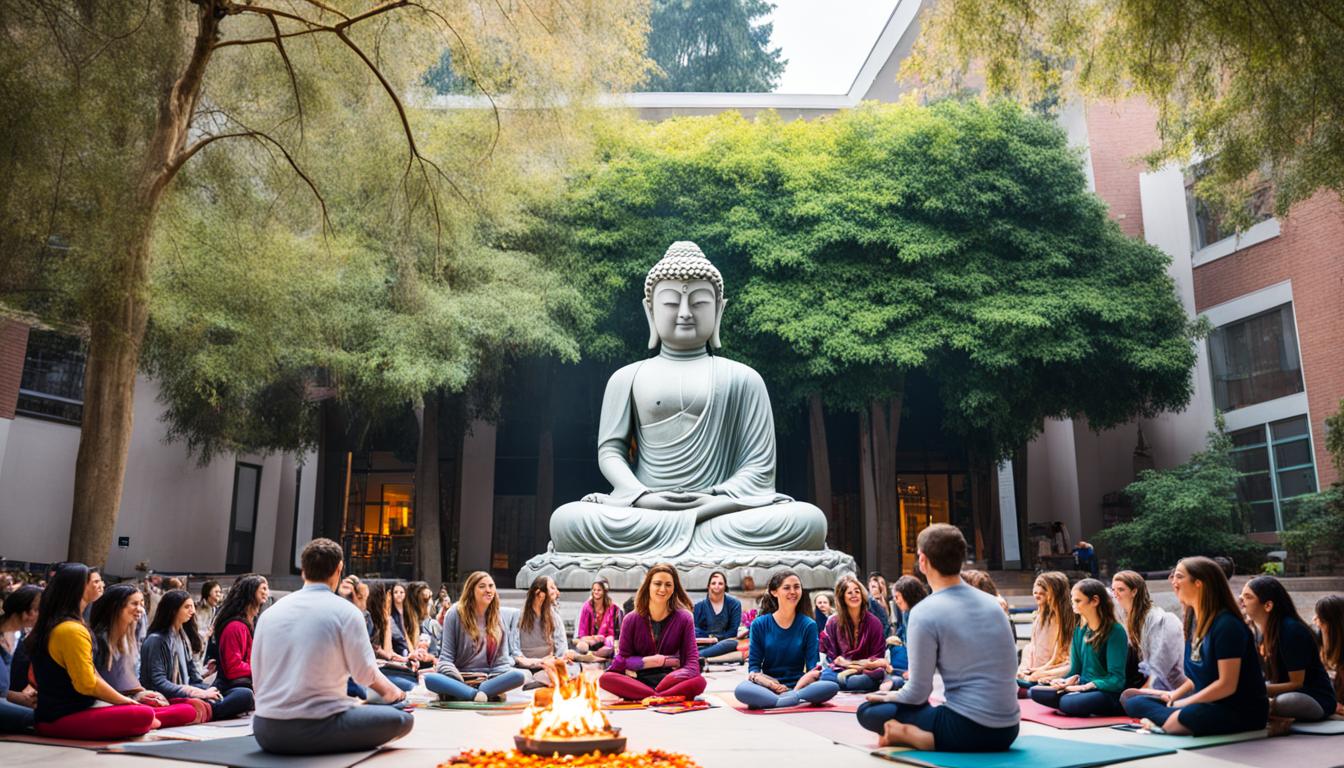Have you ever wondered how Buddhist teachings can bring about a profound transformation in your life? How the principles and practices of a school of Buddhism can unlock your inner peace and wisdom? If you’re curious about delving into mindfulness practices, meditation techniques, and the rich philosophical traditions of Buddhism, then you’re in the right place.
Buddhism education goes beyond theory; it encompasses a way of life that integrates Buddhist teachings into your daily existence. By exploring a school of Buddhism, you can gain insights and tools for personal growth, emotional well-being, and navigating the challenges of modern life.
Key Takeaways:
- Discover the transformative power of Buddhist teachings and practices.
- Uncover the wisdom and guidance offered by a specific school of Buddhism.
- Explore mindfulness practices and meditation techniques for emotional well-being.
- Gain insights into the rich philosophical traditions of Buddhism.
- Navigate the challenges of modern life with the wisdom of Buddhism.
Volunteering and Living in a Buddhist Monastery
One way to deepen your understanding of Buddhism is by volunteering and living in a Buddhist monastery. This unique opportunity allows you to immerse yourself in the daily activities of the monastery, gaining firsthand experience of their teachings and cultural practices.
When you volunteer in a Buddhist monastery, you become an active participant in their community. You will have the chance to engage in various activities, such as assisting with domestic work, tending to the monastery’s maintenance, and even teaching English to the monks. Each task will provide you with valuable insights into the monastery’s lifestyle, discipline, and traditions.
Living in a Buddhist monastery offers a transformative experience of cultural immersion. Being surrounded by monks and fellow volunteers, you can develop a deep understanding of their way of life and spirituality. By observing their daily rituals, participating in prayer sessions, and listening to their teachings, you gain a profound appreciation for the wisdom and practices of Buddhism.
Through this volunteer program, you not only contribute to the monastery’s community but also deepen your own spiritual practice. The teachings you receive and the experiences you encounter will guide you towards personal growth and self-discovery.
img src=”https://seowriting.ai/32_6.png” alt=”Buddhist Monastery” align=”center”>
Daily Activities in a Buddhist Monastery
| Activity | Description |
|---|---|
| Prayer Sessions | Participate in morning and evening prayers, connecting with the spiritual rituals of the monastery. |
| Domestic Work | Assist with cooking, cleaning, and other tasks essential to the monastery’s daily functioning. |
| Teaching English | Engage with the monks by teaching them English, fostering language skills and cultural exchange. |
| Meditation Practices | Learn and practice meditation techniques under the guidance of experienced monks. |
| Scripture Study | Engage in studying Buddhist scriptures and texts, delving deeper into the teachings of Buddhism. |
By embracing this living experience, you embark on a journey of cultural immersion and personal transformation. The insights gained during your time in the Buddhist monastery will continue to shape your understanding of Buddhism long after you leave.
Exploring the Origins and Historical Development of Zen Buddhism
Zen Buddhism, with its emphasis on direct experience, mindfulness, and inner peace, traces its origins back to ancient India. It originated as a school of Mahayana Buddhism known as Chan. The transmission of Zen from India to China is credited to Bodhidharma, who carried the essence of Zen teachings and further developed it into the Zen tradition.
The historical development of Zen Buddhism continued with its transmission to Japan in the 12th century, during the Kamakura period. This led to the establishment of influential Zen schools, such as Rinzai and Soto, each with its own unique approach to practice and philosophy.
Let’s delve deeper into the historical development of Zen Buddhism and explore its origins, transmission, and the influential Zen schools and masters it has produced.
Origins of Zen Buddhism
Before it became known as Zen, this school of Buddhism originated in ancient India as Chan. Chan Buddhism emerged during the Tang Dynasty and integrated elements of Indian Mahayana Buddhism, Taoism, and indigenous Chinese culture. The Chan tradition prioritized direct experience and meditation, aiming to bypass intellectual analysis and directly perceive one’s true nature.
Transmission and Development in China
Bodhidharma, an Indian monk believed to be the first patriarch of Zen Buddhism, played a vital role in the transmission of Zen teachings from India to China. Known for his teaching of “wall-gazing” meditation, Bodhidharma introduced a direct approach that involved seated meditation (zazen) as a means to cultivate insight and awaken to one’s true nature.
In China, Zen Buddhism flourished and evolved under the influence of various masters. Notably, the Tang Dynasty saw the rise of influential Zen masters like Huineng, who is revered as the sixth patriarch of Chan Buddhism. These masters further refined the practice, incorporating elements of Taoist teachings and inspiring future generations of Zen practitioners.
Transmission to Japan and Zen Schools
The arrival of Zen Buddhism in Japan can be traced to the 12th century when the monk Eisai brought the Rinzai sect to the country. The Rinzai school emphasized the use of koans, paradoxical questions or statements, as a means to provoke insight and break through conceptual thinking. It prioritized direct transmission from master to student and placed a strong emphasis on disciplined practice.
Alongside Rinzai, the Soto school was introduced by Dogen Zenji, who stressed the practice of shikantaza, or “just sitting.” The Soto school placed emphasis on everyday mindfulness, considering zazen as an integration of meditation and daily activities.
Both Rinzai and Soto have had a profound influence on Japanese culture and continue to be prominent Zen sects in Japan and around the world.
Zen Masters: Guiding the Path
Throughout history, Zen Buddhism has produced countless revered Zen masters who have dedicated their lives to deepening and transmitting the teachings. These masters, through their own direct experience and realization, have guided students on the path of awakening.
From traditional masters like Hakuin Ekaku and Dogen Zenji to modern Zen teachers like Thich Nhat Hanh and Shunryu Suzuki, each master brings a unique perspective and embodiment of the Zen teachings.

| Zen School | Key Characteristics | Renowned Zen Masters |
|---|---|---|
| Rinzai | Emphasis on koan practice and direct transmission | Hakuin Ekaku, Wumen Huikai, Hakuin’s disciple, and many more |
| Soto | Focus on everyday mindfulness and “just sitting” practice | Dogen Zenji, Shunryu Suzuki, and others |
Core Principles and Philosophical Underpinnings of Zen Buddhism
At the core of Zen Buddhism are principles that guide practitioners on the path to awakening. Zen teachings emphasize the non-dual nature of reality, transcending dualistic distinctions and recognizing the interconnectedness of all phenomena. The concept of emptiness in Zen points to the lack of inherent existence in all things, emphasizing the interplay of causes and conditions. These principles form the philosophical underpinnings of Zen Buddhism and provide a framework for practitioners to cultivate mindfulness and insight.
The Non-Dual Nature of Reality
Zen philosophy highlights the fundamental non-duality of reality. It goes beyond the conventional understanding of opposites and transcends dichotomies such as good/bad, self/other, or spiritual/material. Zen practitioners are encouraged to recognize the interconnectedness of all things and embrace the oneness of existence. This non-dual perspective allows for a deeper understanding of the interdependence and interrelatedness we share with the world around us. By letting go of dualistic thinking, individuals can experience a sense of unity and interconnectedness that extends beyond conventional boundaries.
Emptiness and the Interplay of Causes and Conditions
In Zen Buddhism, the concept of emptiness points to the lack of inherent existence in all phenomena. It emphasizes that everything is impermanent, devoid of a fixed or independent self. Emptiness does not imply a vacuum or nothingness but rather recognizes the interdependent nature of all things. This recognition highlights the interplay of causes and conditions that give rise to the ever-changing flux of existence. By understanding and embracing the emptiness of phenomena, Zen practitioners cultivate a sense of freedom from attachment and develop a deeper appreciation for the interconnectedness of life.

Practices and Methods of Zen Buddhism
Zen Buddhism offers a variety of practices and methods that can help you cultivate mindfulness, attain inner peace, and deepen your understanding of the nature of reality. Through meditation, zazen, koan practice, and everyday mindfulness, you can embark on a transformative journey of self-discovery.
Meditation: At the heart of Zen Buddhism lies meditation, which serves as the primary tool for realizing enlightenment. By practicing meditation, you can quiet the mind, cultivate awareness, and develop a deep sense of presence. Through consistent meditation practice, you can learn to observe your thoughts and emotions without attachment or judgment, allowing you to experience a state of calm and clarity.
Zazen: Central to Zen practice is zazen, a form of seated meditation. During zazen, you sit in a stable and comfortable position, typically cross-legged on a meditation cushion or bench. The focus of zazen is on maintaining a gentle and relaxed posture while directing your attention inward. You can anchor your awareness on the breath, using it as a point of concentration to cultivate a calm and concentrated state of mind.
Koan Practice: Another important aspect of Zen Buddhism is the practice of koans. Koans are enigmatic questions or statements that defy rational thinking and aim to provoke deep insight and realization. By engaging with koans, you can transcend conceptual limitations and tap into intuitive wisdom. Koans challenge the intellect and encourage direct experiential understanding, facilitating a profound shift in perception.
Everyday Mindfulness: Zen Buddhism emphasizes the integration of mindfulness into everyday activities. By approaching ordinary tasks with complete presence and awareness, you can cultivate mindfulness in all aspects of your life. Whether you’re walking, eating, or engaging in routine chores, Zen encourages you to bring your full attention to the present moment, discovering the profound beauty and interconnectedness inherent in even the simplest actions.
By incorporating these practices into your daily life, you can nurture a deeper sense of self-awareness, tranquility, and spiritual growth. Let us explore the potency of these Zen practices and discover the transformative power they hold.

| Practice | Description |
|---|---|
| Meditation | Centering the mind and cultivating inner calm through contemplation and self-reflection. |
| Zazen | Focusing on seated meditation, practicing stillness, and developing deep concentration. |
| Koan Practice | Engaging with paradoxical questions or statements to transcend rational thinking and access intuitive wisdom. |
| Everyday Mindfulness | Cultivating present-moment awareness and mindfulness in daily activities, fostering a sense of interconnectedness. |
Conclusion
Zen Buddhism offers a profound and transformative path to awakening, guiding you on a journey towards inner peace, mindfulness, and spiritual growth. Through dedicated practices such as meditation and the exploration of core principles, Zen opens doors to deeper self-discovery and a heightened sense of awareness.
By embracing the teachings of Zen Buddhism, you embark on a transformative journey towards self-realization and enlightenment. The path of Zen encourages direct experience, allowing you to cultivate mindfulness in all aspects of life. Through the practice of meditation, you learn to quiet the restless mind and uncover the profound wisdom within.
With Zen as your guide, you navigate the challenges of modern life with grace and equanimity. The teachings of Zen remind you to stay present, to fully engage with each moment, and to cultivate a sense of interconnectedness with all beings. By embodying these principles, you cultivate inner peace and harmony, transforming your relationship with yourself and the world around you.
In your journey with Zen Buddhism, you discover the transformative power of mindfulness and the path to awakening. As you delve deeper into meditation and embrace the core principles of Zen, you unlock the full potential of your being. The wisdom and insights gained through your practice allow you to navigate the complexities of life with clarity, compassion, and a profound sense of inner peace.
FAQ
What teachings can I expect to learn from a school of Buddhism?
Buddhism offers a rich array of teachings that can transform your life. You can explore mindfulness practices, meditation techniques, and the philosophical traditions of Buddhism, providing insights for personal growth and navigating the challenges of modern life.
How can volunteering and living in a Buddhist monastery enhance my understanding of Buddhism?
Volunteering and living in a Buddhist monastery allows you to immerse yourself in the daily activities of the monastery, such as prayer, assisting with domestic work, and teaching English to the monks. By living in the monastery, you can gain firsthand knowledge, cultural immersion, and learn about their lifestyle, discipline, and traditions, deepening your own spiritual practice.
What is the historical origin of Zen Buddhism?
Zen Buddhism, which emphasizes direct experience, mindfulness, and inner peace, has its roots in a school of Mahayana Buddhism called Chan, originated in ancient India. Bodhidharma is credited with transmitting the essence of Zen from India to China, where it further evolved into the Zen tradition before reaching Japan.
What are the different Zen schools that developed in Japan?
The transmission of Zen to Japan in the 12th century led to the establishment of influential Zen schools, such as Rinzai and Soto. These schools differ in their approaches to practice and have produced renowned Zen masters throughout history.
What are the core principles of Zen Buddhism?
Zen Buddhism emphasizes the non-dual nature of reality, transcending dualistic distinctions and recognizing the interconnectedness of all phenomena. The concept of emptiness in Zen refers to the lack of inherent existence in all things, emphasizing the interplay of causes and conditions. These principles provide a framework for practitioners to cultivate mindfulness and insight.
How does Zen Buddhism approach meditation?
Zen Buddhism places meditation, particularly zazen or seated meditation, at the forefront of its practice. Practitioners focus their attention on the breath or engage with koans, paradoxical questions or statements used to provoke insight. Zen also encourages practicing mindfulness in everyday activities, such as walking and eating, to deepen understanding of impermanence and interconnection.
What benefits can I expect from embracing Zen Buddhism?
By embracing the teachings of Zen Buddhism, you can embark on a transformative journey of spiritual growth and self-discovery. You can develop mindfulness, experience direct insights, and cultivate a deeper sense of inner peace and fulfillment, providing guidance for navigating the challenges of modern life.

